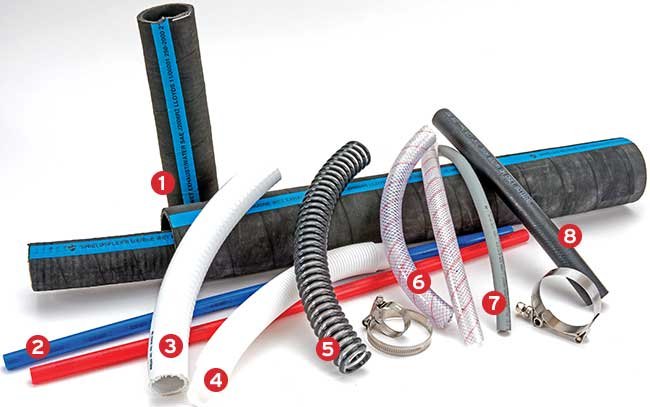
There is no such thing as an all-purpose hose on a boat. No single hose type can withstand engine exhaust, bring freshwater to the galley, safely transport gasoline to the carburetor, drain the cockpit, and flush the head. Using the wrong hose can cause problems that range from an inconvenient mess to a burning boat. This handy run-down will help you identify one type of hose from another and assist in choosing the right hose for the job at hand. We'll start with a visual guide to common marine hoses, then go into more detail about each type.
1. Exhaust hose. Able to withstand temperatures to around 250 F, an exhaust hose is often reinforced with wire, which may be stainless, or other special reinforcement. Other, more expensive silicone hoses are capable of sustaining much higher temperatures.
2. Hot and cold PEX potable water pipe. Many modern boats use PEX tubing for hot and cold plumbing. PEX is available in three distinct grades: A, B, and C. Although all are perfectly acceptable for potable water, Grade A is the most flexible and easiest to run in the tight confines of a boat. Fittings are easy to connect to the pipe, although you may need special tools. PEX is not the only option for potable water, however (see 6).
3. Sanitation hose. Often white, with a smooth bore to prevent trapping waste that could lead to odors, sanitation hose has an expected lifespan of approximately 10 years.
4. Corrugated bilge pump hose. This cheap hose is often supplied with bilge pumps. While easy to run, cut, and bend, its ridged internal structure restricts flow, making it a poor choice.
5. Smooth-bore bilge pump hose. Although four times the price of corrugated types, smooth-bore bilge pump hose offers up to 30 percent greater efficiency.
6. Potable water hose. Potable water hose comes in both reinforced and non-reinforced types. They're easy to tell apart as the reinforced hose will have strong synthetic cord strands visible. This one is clear but opaque is generally a better choice for potable water because there is less chance of algae growing inside.
7. Fuel hose. Fuel hose must be marked as such and will be stamped A1, A2, B1, or B2. Older hoses are incompatible with fuel containing ethanol, so if yours is older than about 10 years, it's most likely due for replacement anyway.
8. Thru-hull hose. For any connections to thru-hulls, reinforced hose is the only way to go. A cheap hose may fail and sink your boat.